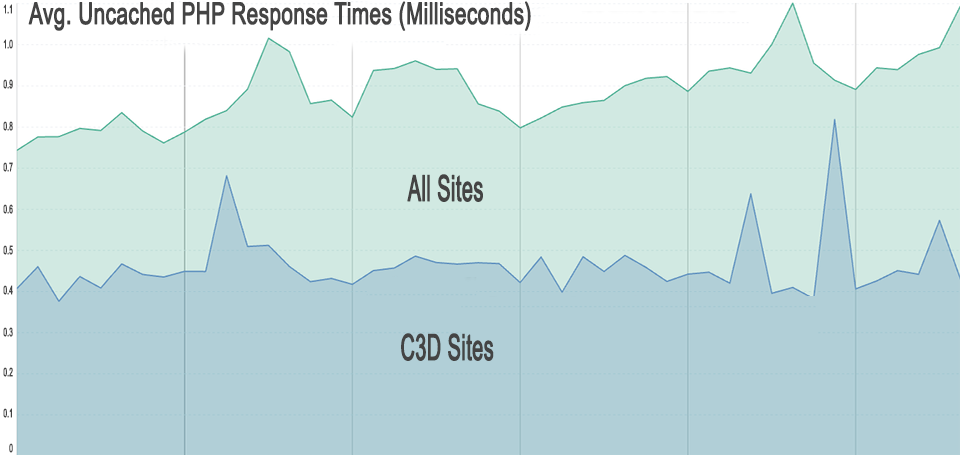When the Google Cloud Platform (GCP), which underlies Kinsta’s hosting infrastructure, introduced a new generation of hardware to some of its data centers in late 2023, we asked if the technology could make our own platform faster and more reliable.
The answer to that question was a resounding yes, and now we’re migrating customers to these new C3D machines where GCP has made them available.
For many customers, C3D VMs will replace the C2 machines that have headlined Kinsta’s cloud story. So, let’s take a closer look at how customers will benefit from this no-cost upgrade.
C3D VMs Get a Real-World Test
“Ensuring top-tier site speed is our North Star, guiding every decision we make,” said Laszlo Farkas, Kinsta’s Director of Engineering. “It remains our number one commitment to our clients, shaping the future of our services.”
Kinsta conducts comprehensive lab tests for every new GCP machine type to assess its performance and resiliency. The lab tests are methodically segmented to accurately compare different machine types. This rigorous approach was used before introducing the C2 machines, and the same process was repeated to evaluate the C3D technology.
“The lab testing is central to our commitment to delivering the best possible performance for client sites,” Farkas said. “However, putting real sites and real client workloads on the machines is also critical.”
Kinsta’s engineering team conducted a thorough assessment over several weeks to gauge the efficiency of a C3D-based host machine that had been operating in production for two months. The investigation revealed that the C3D machine delivered response times 20% to 50% faster than legacy machines in this real-world environment.
Farkas said testers saw the most dramatic speed enhancements in requests for uncached PHP pages. Kinsta’s state-of-the-art edge caching and server-level caching already ensure near-instantaneous delivery for cacheable content, minimizing network latency.
But content that requires individualization, like e-commerce shopping carts or user-specific data, must be processed directly by the WordPress core. The new C3D machine type demonstrated its exceptional capabilities, ensuring rapid response times even for the most complex and dynamic content.
C3D VMs also performed better than the legacy machines during requests for cached content. Still, the dramatic improvement with uncached PHP on C3D-hosted sites is clear in the chart below covering five days of traffic:

These kinds of improvements are a big part of why Kinsta continues to earn top marks from customers on platforms like G2, where we’re consistently recognized among the leading WordPress hosting providers.
What Makes C3D Machines Different?
The enhanced speed of the C3D machines can be attributed primarily to a more advanced CPU and improved I/O performance.
AMD’s EPYC (Genoa) processor, which has a maximum frequency of 3.7 GHz, powers the C3Ds. They also have a separate infrastructure processing unit (IPU) to relieve the CPU of some computation required for network switching, security, and storage. This combination results in faster and more reliable performance, particularly in demanding hosting environments.
Farkas said the improvements result in quicker PHP execution and more efficient handling of database requests. Beyond speed, the enhanced I/O improves stability, ensuring a more consistent and dependable hosting experience.
Insights From C3D Lab Testing
Kinsta’s automated lab tests focused on key areas such as disk I/O, database performance, and high-traffic server endurance.
Farkas said the testing environment is crafted to replicate real-life scenarios as closely as possible, including running concurrent tests and maintaining multiple containers on each server to simulate actual production hosts.
Here are results highlights:
Web Request Simulation
The team used the Siege HTTP load-testing utility to simulate dozens of concurrent users making as many requests as possible for two minutes.
| Machine Type | Transactions | Avg. Response Time (Sec.) |
|---|---|---|
| C3D | 93,320 | 0.04 |
| C2 | 57,436 | 0.06 |
I/O Load Test
The benchmarking tool Bonnie++ was used to test reading from and writing to SSD persistent disks.
| Machine Type | Write (Mebibytes/Sec.) | Read (Mebibytes/Sec.) |
|---|---|---|
| C3D | 314 | 118 |
| C2 | 227 | 36 |
| Note: One mebibyte equals 1.048576 megabytes. | ||
MySQL Stress Test
The mysqlslap load emulation client simulated dozens of concurrent MySQL connections executing simultaneous queries. “I/O wait” values represent the average lag before a disk read or write operation in response to a query.
| Machine Type | I/O Wait (Milliseconds) |
|---|---|
| C3D | 0.9 |
| C2 | 86 |
“Based on the lab tests, C3D had outstanding performance,” Farkas said.
Power Your Site With C3D Technology
GCP has deployed its C3D machines to 11 regional data centers:
- Changhua County, Taiwan (asia-east1)
- Mumbai, India (asia-south1)
- Jurong West, Singapore (asia-southeast1)
- Sydney, Australia (australia-southeast1)
- St. Ghislain, Belgium (europe-west1)
- Frankfurt, Germany (europe-west3)
- Eemshaven, Netherlands (europe-west4)
- Council Bluffs, Iowa, USA (us-central1)
- Moncks Corner, South Carolina, USA (us-east1)
- Ashburn, Virginia, USA (us-east4)
- Las Vegas, Nevada, USA (us-west4)
This means that this powerful technology isn’t available to all of the 37 data centers used by our customers. We’re monitoring C3D availability and migrating the sites of our Managed WordPress Hosting customers where possible.
However, you can select a C3D-capable data center when you add a new WordPress site. Data centers with C3D machines ready for your next site are flagged as “Boosted” in the data center selection drop-down.


